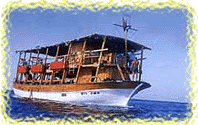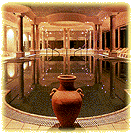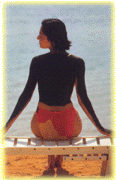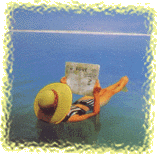 |
 |
 |
|
|||
|
In honor of spring we thought we'd bring you the sound of grackles: they're black birds, but the type you're hearing have red flashes on their wings. And they only live in one place, the Dead Sea, which is also the saltiest body of water on earth. But it's not just birds that find this area appealing. For thousands of years the Dead Sea has attracted people seeking health cures and rejuvenation. Patricia Golan struck out from her home in Jerusalem to explore the healing properties of the Dead Sea. Spa Vacations at the Dead Sea
Life in Israel is hectic for anyone, especially a journalist. I'd been to the Dead Sea before, when hit by a double whammy of asthma and arthritis. This time I decided to return just to unwind. Halfway into the descent from Jerusalem you reach a stone marker on the highway saying "sea level." From here, you must descend another 1300 feet (a journey of six miles) to reach the Dead Sea.
At the southern half of the Dead Sea is the area of Ein Bokek, chock-full of hotels. From there to get out into the desert wilderness, you need a four-wheel drive.
My guide Shlomi leads us across the desert sands in his all-terrain vehicle to the area known as S'Dom - Sodom of biblical Sodom and Gomorrah fame. The desert route is dotted with salt bushes and the occasional acacia or tamarix tree. Along the way we see ibex and gazelles.
Piles and piles of jagged blocks of salt, they almost look like crystals, and the landscape is quite lunar. It's very forbidding really, just one huge mountain of salt. Patricia: "O.K. I want to try to lick this. Here's a chunk, a chunk of salt, wow! It's like taking a tablespoon of salt, my God, amazing. Whew. Okay." It's mainly because of the salt and other minerals that tourists have been drawn to the Dead Sea area for thousands of years. Dr. Marco Harari is medical director of one of the local clinics. Harari: "Two thirds of patients coming to the Dead Sea are suffering from psoriasis, this is a chronic skin disease. We are able in this disease to bring a remission period of about nine months to one year, after treatment after treatment at the Dead Sea." The Dead Sea area is the only place on earth where the sun is not harmful. At 1300 feet below sea level, the sun's radiation is filtered and UV-rays weakened. The combination of sun, Dead Sea waters and mineral baths constitute the cure - not only for people suffering from skin diseases but from respiratory and rheumatoid diseases as well. And the high concentrations of bromine that are released from the Dead Sea into the atmosphere have a calming effect on the nervous system, no matter how strung out you may be.
The spa has a private medical center where I inquire about therapies. Patricia: "I'm supposed to get a mud treatment next. What is this going to do to me? Can you tell me what the benefits are of this mud treatment?" Elena is one of the thousands of immigrants from Russia who have found jobs in the spa industry. She explains that the mud penetrates the joints and helps people with arthritis and other rheumatic problems. It's called "Balneotherapy." Just what I need. Unfortunately, I don't get to experience the hot mud. The spa management can't seem to find a female attendant and since one has to completely strip for the procedure, I decide to pass.
I'm now putting black mud all over me. It's kind of hard to do. Everybody else is doing it over their entire bodies. I think I'll just pat it here and there. I'll do my shoulders and maybe a bit on my face...there are Russians here talking video pictures of themselves. A couple of the women have removed their bras. For about $15, you can spend the day at the Ein Gedi spa. In addition to the mud thing, there are three thermo-mineral pools that are fed directly from underground hot-springs. The strong smell of these sulphur pools takes some getting used to. To get from the Ein Gedi spa to the Dead Sea itself you have to take a trolley. The sea has been slowly receding over the years as a result of evaporation and potash works on both the Israeli and Jordanian sides. In the 13 years since the spa was built, the sea has receded by a mile, but soon I'm at the waterfront, where some tourists are just going into the water.
Patricia: "What's it like?" Relaxing it may be, but Avi, the lifeguard, says he often has to rescue people who accidentally swallow as little as one teaspoon of the salty water. Avi: "The thing is that they don't know how dangerous it is so they're, like, fooling around sometimes, laughing because they're floating and, you know, when you're laughing you don't know what you're doing (hahaha) and (sound of gulping) and then, goodbye!" One or two people a year die in the Dead Sea. They don't tell you that in the brochures. But, says the lifeguard, no one has died in this area in the past year. Development in the Dead Sea area has been growing so fast it has raised alarm bells among green activists. The Jordanian side is far less developed than the Israeli. But several luxury hotels are now under construction in Jordan that will also cater to the visitors seeking "the cure." Like the Israelis, the Jordanians have discovered that even in the worst Middle East tourist slump, the Dead Sea tourist industry will always stay afloat. At the Dead Sea, I'm Patricia Golan for The Savvy Traveler. For more information:
|
 | American Public Media Home | Search | How to Listen ©2004 American Public Media | Terms of Use | Privacy Policy |

 Flanked by the arid Judean Mountains to the west and the Moab Mountains of
Jordan to the east, the Dead Sea glistens under a burning sun. Not a
ripple disturbs its surface. The rocks around the sea's edges are covered with a
snow-like, thick deposit of white salt.
Flanked by the arid Judean Mountains to the west and the Moab Mountains of
Jordan to the east, the Dead Sea glistens under a burning sun. Not a
ripple disturbs its surface. The rocks around the sea's edges are covered with a
snow-like, thick deposit of white salt.
 It looks as if no human has ever passed through here. We reach Mount
Sodom, an 11 mile long mountain range made of pure salt. I follow Shlomi up one
of the hills.
It looks as if no human has ever passed through here. We reach Mount
Sodom, an 11 mile long mountain range made of pure salt. I follow Shlomi up one
of the hills.
 Here is the ultimate in luxury spas - the Mineralia at the Hyatt Hotel in
Ein Bokek. It has Roman-style, glass-enclosed pools looking out on
landscaped gardens and the mountains.
Here is the ultimate in luxury spas - the Mineralia at the Hyatt Hotel in
Ein Bokek. It has Roman-style, glass-enclosed pools looking out on
landscaped gardens and the mountains.
 Well, I missed the hot mud treatment at the Hyatt, but at the
much cheaper, and more user-friendly, Ein Gedi spa there are bins of warm
mud for do-it-yourselfers.
Well, I missed the hot mud treatment at the Hyatt, but at the
much cheaper, and more user-friendly, Ein Gedi spa there are bins of warm
mud for do-it-yourselfers.
 Try as one may, it's impossible to sink in the thick brine, which
is four times as salty as regular sea water. One can, however, recline on
the water to read a newspaper.
Try as one may, it's impossible to sink in the thick brine, which
is four times as salty as regular sea water. One can, however, recline on
the water to read a newspaper.